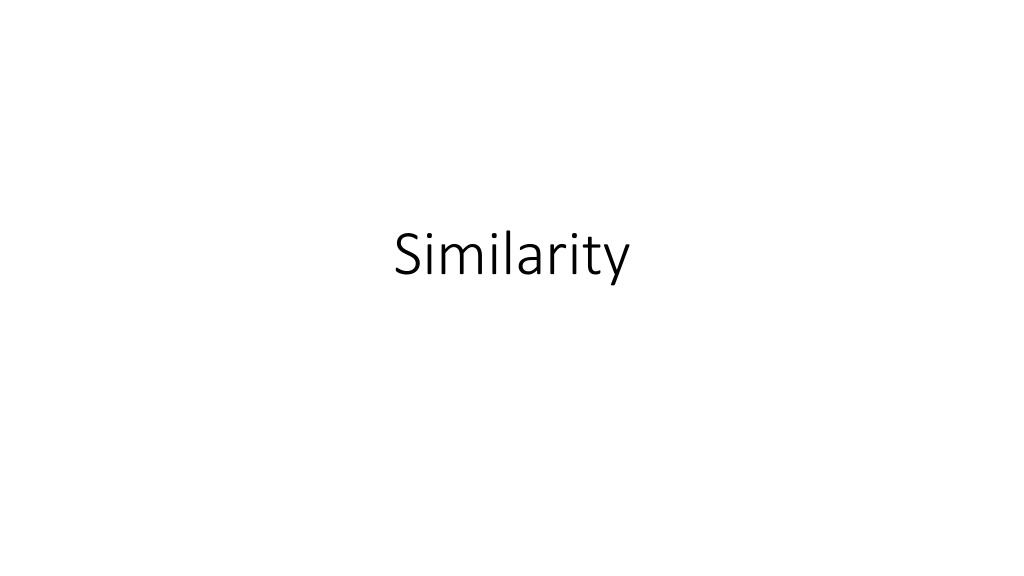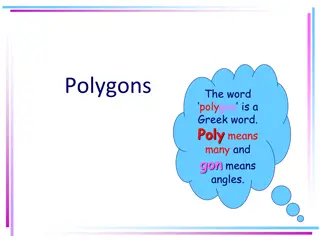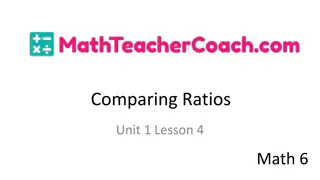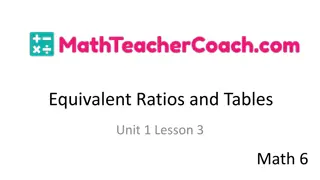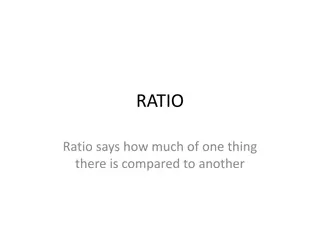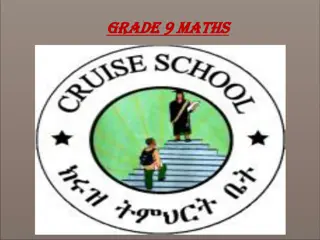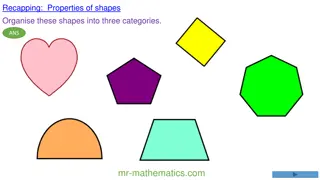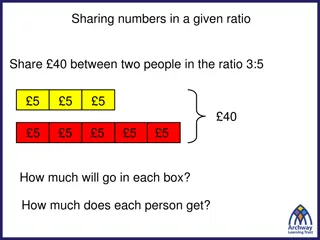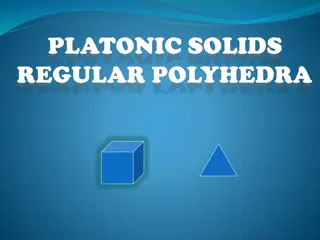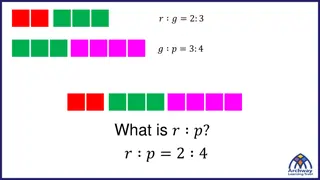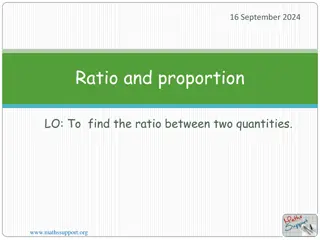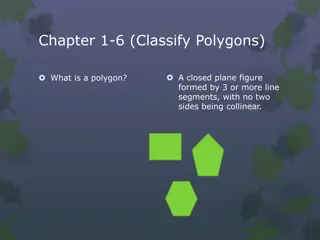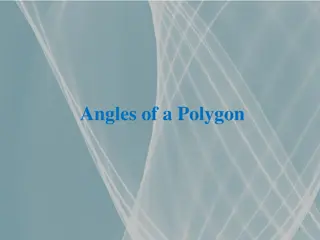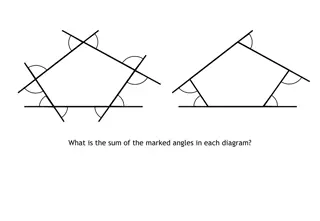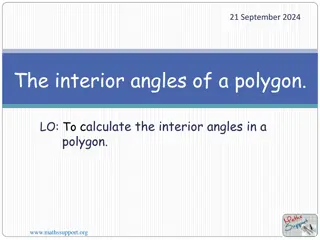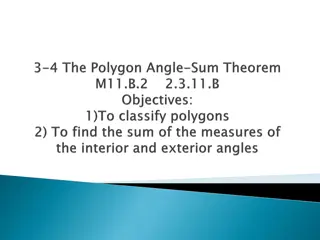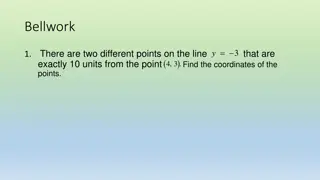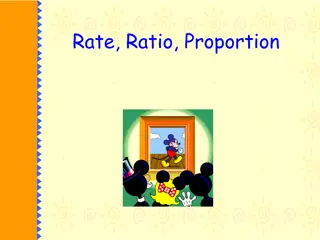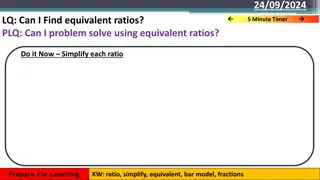Understanding Similar Polygons and Ratios in Geometry
Discover the concept of similar polygons in geometry, identifying congruent angles and corresponding sides, solving proportions, and applying properties to solve problems. Delve into the vocabulary, principles, and examples of similar polygons to gain a comprehensive understanding of the topic. Explore the significance of similarity ratios and statements in determining similarity between polygons.
Download Presentation

Please find below an Image/Link to download the presentation.
The content on the website is provided AS IS for your information and personal use only. It may not be sold, licensed, or shared on other websites without obtaining consent from the author. Download presentation by click this link. If you encounter any issues during the download, it is possible that the publisher has removed the file from their server.
E N D
Presentation Transcript
Warm Up 1. If QRS ZYX, identify the pairs of congruent angles and the pairs of congruent sides. Q Z; R Y; S X; QR ZY; RS YX; QS ZX Solve each proportion. 2. 3. x = 9 x = 18
Objectives Identify similar polygons. Apply properties of similar polygons to solve problems.
Vocabulary similar similar polygons similarity ratio
Figures that are similar (~) have the same shape but not necessarily the same size.
Two polygons are similar polygons if and only if their corresponding angles are congruent and their corresponding side lengths are proportional.
Similar Triangles. http://www.mathopenref.com/similartriangles.html
Example 1: Describing Similar Polygons Identify the pairs of congruent angles and corresponding sides. 0.5 N Q and P R. By the Third Angles Theorem, M T.
Check It Out! Example 1 Identify the pairs of congruent angles and corresponding sides. B G and C H. By the Third Angles Theorem, A J.
A similarity ratio is the ratio of the lengths of the corresponding sides of two similar polygons. The similarity ratio of ABC to DEF is , or . The similarity ratio of DEF to ABC is , or 2.
Example 2A: Identifying Similar Polygons Determine whether the polygons are similar. If so, write the similarity ratio and a similarity statement. rectangles ABCD and EFGH
Example 2A Continued Step 1 Identify pairs of congruent angles. All s of a rect. are rt. s and are . A E, B F, C G, and D H. Step 2 Compare corresponding sides. Thus the similarity ratio is , and rect. ABCD ~ rect. EFGH.
Check It Out! Example 2 Determine if JLM ~ NPS. If so, write the similarity ratio and a similarity statement. Step 1 Identify pairs of congruent angles. N M, L P, S J
Check It Out! Example 2 Continued Step 2 Compare corresponding sides. Thus the similarity ratio is , and LMJ ~ PNS.
Helpful Hint When you work with proportions, be sure the ratios compare corresponding measures.
Example 3: Hobby Application Find the length of the model to the nearest tenth of a centimeter. Let x be the length of the model in centimeters. The rectangular model of the racing car is similar to the rectangular racing car, so the corresponding lengths are proportional.
Example 3 Continued 5(6.3) = x(1.8) Cross Products Prop. 31.5 = 1.8x Simplify. 17.5 = x Divide both sides by 1.8. The length of the model is 17.5 centimeters.
Check It Out! Example 3 A boxcar has the dimensions shown. A model of the boxcar is 1.25 in. wide. Find the length of the model to the nearest inch.
Check It Out! Example 3 Continued 1.25(36.25) = x(9) Cross Products Prop. 45.3 = 9x Simplify. 5 x Divide both sides by 9. The length of the model is approximately 5 inches.
Lesson Quiz: Part I 1. Determine whether the polygons are similar. If so, write the similarity ratio and a similarity statement. no 2.The ratio of a model sailboat s dimensions to the actual boat s dimensions is . If the length of the model is 10 inches, what is the length of the actual sailboat in feet? 25 ft
Lesson Quiz: Part II 3. Tell whether the following statement is sometimes, always, or never true. Two equilateral triangles are similar. Always
